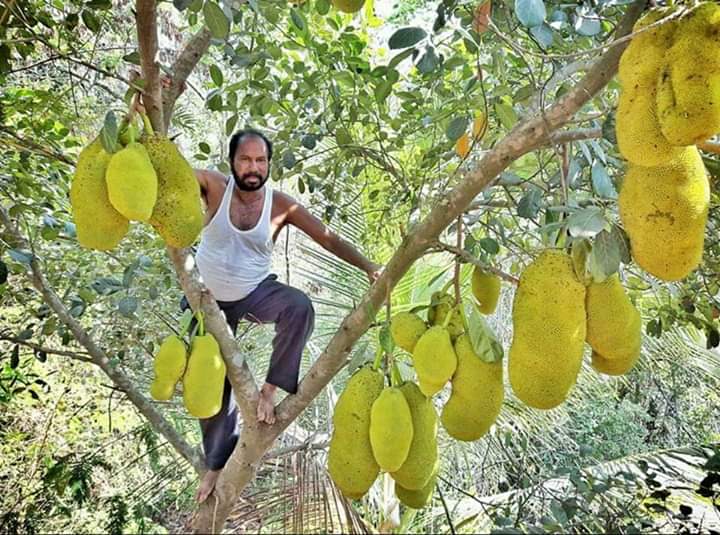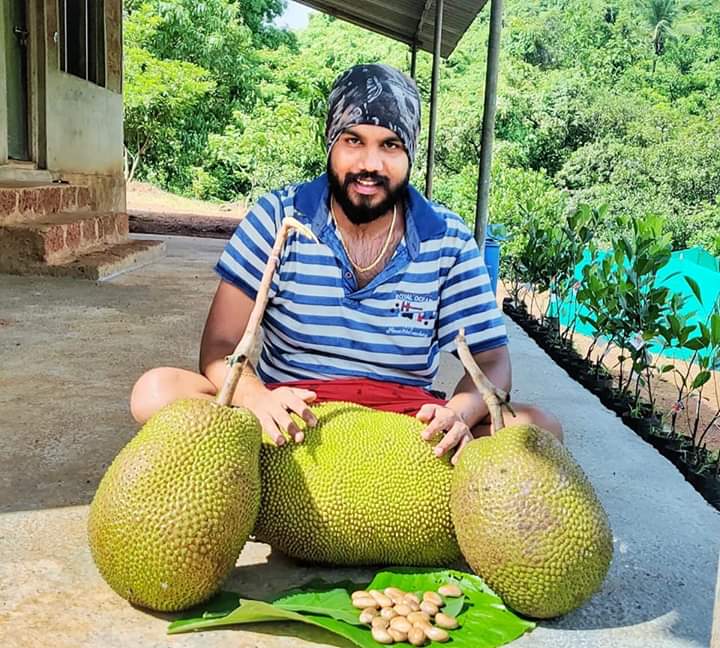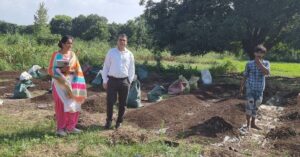‘King Of Jackfruits’, Ratnagiri Farmer Grows 75 Varieties Of Fruit On His Farm
In an effort to popularise the cultivation of the fruit in Maharashtra, Desai has raised a nursery as well.

The village of Zapade, in Maharashtra, is home to a farmer who is unique in a way — he has steered clear of growing Alphonso mangoes, which are a favourite of every Konkan farmer. Instead, he has introduced the cultivation of jackfruit. In all likelihood, Harishchandra Desai is the only farmer in the state to have devoted 13 acres of his farmland — located in Lanja taluka of Ratnagiri, to solely growing this otherwise ignored fruit.
At 60, Desai looks towards a future when the phanas (the Marathi word for jackfruit) will receive its dues for bringing prosperity to farmers in the wettest region of the state. “Every year, a week before Vat Poornima in June, traders arrive at the Konkan villages to pick jackfruits and pay a paltry of Rs 5 to Rs 10 per fruit,” says Desai, adding, “I want to change that.”
He believes that farmers can earn Rs 100 to Rs 200 per fruit, as they did in Toobugere village in Karnataka after a jackfruit growers’ association was formed there. This was the first and only such association in the country with direct connectivity to the market.
Zapade is located 4 km away from Lanja, and has a total population of 600. Like most villages in Ratnagiri, the major crops grown here are mango, coconut, cashew, nutmeg, jackfruit, betel nut, rice and ragi. In the villages of the Konkan region like Raigad, Ratnagiri and Sindhudurg, one is likely to find one or two jackfruit trees at any household, scattered as a border crop for which farmers do nothing except harvest the fruits. In fact, harvesting is not done as a matter of routine and the fruits are often let to rot and fall.
Jackfruit – The fruit of the future
There are two kinds of jackfruit — the softer rassal, and the firmer kaapo. Tender jackfruit is used to make phanasachi bhaji, while ripe ones are sold as fruits. Grown mostly without any management practices, jackfruits are promising fruits grown organically by default. Researchers believe the fruit could be a replacement for wheat, corn and other staple crops that are under threat from climate change. According to Dr P Rajendran of Kerala Agriculture University, jackfruit trees are solar efficient, and in a five-year period, add 12 per cent organic carbon to the soil, which is equivalent to 40 tonnes of carbon.
Largely, due to its odour, the jackfruit never gained popularity in the country, unlike in the far eastern nations. The fruit’s botanical name, Artocarpus, is derived from the Greek word artos (bread) and carpos (fruit). It’s name comes from the Portugese word jaca. Its origin is identified with the evergreen rainforests of Western Ghats, the fruit also grows in Tamil Nadu, Karnataka, Maharashtra, Andhra Pradesh, Telangana, Odisha, West Bengal, Uttar Pradesh, Bihar, Chhattisgarh, Jharkhand, Madhya Pradesh, and in the northeastern states.
The world’s largest fruit is called by a variety of names — Chakka (Malayalam); Kathal (Hindi), Phanas (Marathi); Kathal, Gach Patha (akin to vegetarian meat) and Enchor (Bangla); and Halasu, Kujee and Halasina Hannu (Kannada). Every region of India has a unique way of preparing this versatile fruit. It can be deep-fried or made as dry or wet gravies, as well as into cutlets. Of late, freeze-dried tender jackfruit flour has come as manna for diabetics.
Though Desai’s farm plot is located on a hilly terrain close to the perennial river Beni, he practices drip irrigation on his jackfruit orchard, which has lemon, ginger and turmeric as intercrops. “I want to prove that one can have a drip-irrigated jackfruit plantation. I adopted this method due to non-availability of farm hands,” he says.
‘Phanasachi Raja’
In an effort to popularise the cultivation of the fruit in Maharashtra, Desai has started a nursery as well. During the lockdown owing to the pandemic, he sold around 3,000 saplings to growers from Sangli, Nashik, Pune, Panshet, Karad and Satara, and has an additional 10,000 saplings awaiting sale. “I educate the prospective grower on selecting a variety according to one’s agro climate. What is grown in Ratnagiri is not suitable for a dry region, like Karad,” he says.
Desai advises farmers to limit the vertical growth of the tree while encouraging its horizontal spread. His mantra is, “Don’t let it grow beyond 12 to 15 ft. That will make it easy to pluck the fruit.”
He has close to 75 varieties growing on his orchard and is well-versed with details such as the place of its origin, preferred region for its planting, the month it bears fruit, its total weight, colour of its fruit bulb and its weight when harvested. He can rattle their fancy names too, like Super Early, Jalbhog Raja, Champadak, Singapoori, Vietnam Seedless, J 33, Milky White, Madagascar Gomleos, Ramchandra, Tubbogera, Kaudisingana Kachahalli etc. A variety developed by him and named Desai Kappa, which he considers to be the sweetest, is very popular among growers in Kerala. He even guides the farmers on the fruit’s TSS (Total Soluble Solids), aka its sugar content. “I have trees with fruits that have TSS between 15 to 30 per cent,” he says.
A former employee of Ratnagiri’s District Hospital, Desai has collected varieties of the jackfruit from within the country and from countries like Thailand, Sri Lanka, Malaysia and Vietnam. His 1,250 plus plants of different cultivars are spread across 13 acres and yield at different times of the year. On the remaining 10 acres, he grows cashew. Interestingly, he was the only farmer from Maharashtra to attend the 2017 International Jackfruit Festival held in Wayanad, Kerala. His passion for the fruit has earned him the title, “Phanasachi Raja (King of Jackfruit)” in Maharashtra. He is ably supported in his ‘jackfruit mission’ by his son, Mithilesh (28), an Agri Engineer and a Civil Services aspirant who has abandoned his dream to become a farmer instead.

According to Desai, a mature jackfruit tree can produce some 200 fruits per year, with older trees bearing up to 500 fruits in a year. With hardly any labour costs, no fertilizer and no pesticide, the fruit has the potential to make farmers earn lakhs. “It’s only during the harvest that you need additional hands,” says Desai, who has formed a Farmer Producers Company with 500 jackfruit farmers and prospective jackfruit growers.
Sri Padre, editor, Adhike Patrike, who has an encyclopedic knowledge about the fruit and believes in its potential to bring a radical change in the life of the growers, has this to say about Desai: “He has taken an interest in the jackfruit when no one else is serious about it in the Konkan region. He has shown a model and displayed a professional approach that can bring good dividends. Systematic cultivation, promotion of the fruit and a bit of marketing can take care of the farmer’s livelihood for decades. What is remarkable is that he is supported in this endeavour by his son.”
(Edited by Divya Sethu)
If you found our stories insightful, informative, or even just enjoyable, we invite you to consider making a voluntary payment to support the work we do at The Better India. Your contribution helps us continue producing quality content that educates, inspires, and drives positive change.
Choose one of the payment options below for your contribution-
By paying for the stories you value, you directly contribute to sustaining our efforts focused on making a difference in the world. Together, let's ensure that impactful stories continue to be told and shared, enriching lives and communities alike.
Thank you for your support. Here are some frequently asked questions you might find helpful to know why you are contributing?


This story made me
-
97
-
121
-
89
-
167














